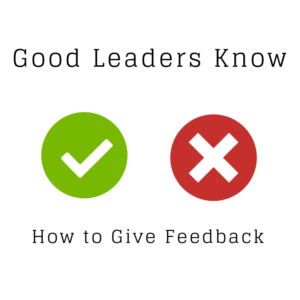 A recent piece in the Wall Street Journal discussed the rare worker that thrives on negative feedback. The author makes the point that leaders often shy away from giving this feedback, but in fact, it can be motivating for the person receiving it. I’ll agree with this point however, I also believe the reason so many people can’t hear it or don’t respond well to negative feedback is because of how it’s delivered.
A recent piece in the Wall Street Journal discussed the rare worker that thrives on negative feedback. The author makes the point that leaders often shy away from giving this feedback, but in fact, it can be motivating for the person receiving it. I’ll agree with this point however, I also believe the reason so many people can’t hear it or don’t respond well to negative feedback is because of how it’s delivered.
In a performance review, my experience has been that we all listen for the bad, or weaknesses and pay more attention to them than we do the good. This is human nature, what’s wrong, what can I fix, etc. We give this more weight than what we are doing well, even if it’s just 10% of our overall feedback. We often give it outsized importance and weight, in some cases completely ignoring the 90% of good feedback.
Coupled with leaders and managers inability to deliver well, one can’t truly fix a weakness. We can mitigate it, but it can’t be fixed. If you look at all the research from Gallup around the tool Strengthsfinders, you will see that they have shown no one can operate from an area of weakness, only from an area of strength. Most of the examples cited in the article were not actual weaknesses, but merely behaviors that needed to be changed. Those are not weaknesses, it’s about something that needs to be executed differently. By naming it as a weakness we have already labeled it as bad and lessened the likelihood that it can be changed. By simply naming a behavior that can be changed to achieve a better outcome, you have a much higher likelihood of achieving the desired outcome.
As a leader, start by naming the outcome that you would like to have, meaning the change you would like to see. Identify any institutional barriers that are in the way of achieving it. Then look at the behaviors that have contributed to not achieving that outcome – talking to the wrong client; not communicating effectively; not working on the right projects; not delivering in a timely manner, etc. You get the idea. Once you have a desired future state defined, that is different than where you are today, you can identify the roadblocks that are in the way. What does this person need to do differently? It’s not bad or good, it’s simply is or is not getting them the result needed to be successful.
Next, it’s important to separate the behavior from the person. It’s not attached to them like a barnacle, it’s likely a behavior that if made aware of it, they can change. When a person is self-aware, they likely self-correct frequently along their career path. Always learning from both successes and failures and adjusting accordingly. Name it for what it is and move on. The behavior doesn’t define them unless they are unwilling to change and learn something new.
Lastly, provide coaching or training for the new behavior as needed. When was the last time you learned something new on your own, without help or by accident? Not very often. Good leaders know to provide support for people to change behaviors. It’s not about pointing out someone’s weakness or always asking about our own, it’s about connecting the dots to the future state we want and getting some help along the way.
